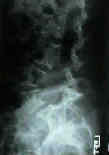- See:
- Neurofibromatosis
- Scoliosis
- Discussion: 


- 2 subtypes: idiopathic and dystrophic;
- dysplastic type: (dystrophic)
- short, sharply angulated curve which involve only few vertebra;
- associated w/:
- neural foramina enlargement
- rib penciling
- kyphosis;
- vertebral body scalloping
- dural ectasia
- soft tissue masses;
- references:
- Pathophysiology of spinal deformities in neurofibromatosis. An analysis of 71 patients who had curves associated with dystrophic changes.
- Modulation of spinal deformities in patients with neurofibromatosis type 1.
- MRI: evaluates dystrophic forms to characterize soft tissue masses;
- Treatment: of Dysplastic Scoliosis;
- one can expect relentless progression that is refractory to bracing;
- surgical fusion is therefore required;
- w/ scoliosis alone: posterior arthrodesis (w/ internal fixation);
- w/ associatted kyphosis there is increases risk of paraplegia & pseudo-arthrosis following surgery;
- anterior fusion combined w/ posteiror instrumentation & fusion is indicated when kyphosis > 50 deg or scoliosis is > 80 deg
Pitfalls of spinal deformities associated with neurofibromatosis in children.
Scoliosis surgery in neurofibromatosis.
Cotrel-Dubousset instrumentation in neurofibromatosis spinal problems.
Cervical spine abnormalities in neurofibromatosis.
Spine deformity in neurofibromatosis. A review of one hundred and two patients.
Neurofibromatous scoliosis. Natural history and results of treatment in thirty-seven cases.




